
Likert Scale Surveys – Definitions and How to Create One Easily (2022)
Feedback on your products and services should be painless to obtain for the user. As such, this post will show you how to create Likert scale surveys!
Obtaining feedback on and carrying out research for your products and services is high on the list of essential growth strategies. A Likert scale survey is a super way to achieve both of these tasks, due to its ease of use and versatility.
While you need to ask the right questions, having a consistent and quantifiable way to collate the answers is also crucial. A Likert scale survey gives you clear, understandable results that are easy to process. You can find these types of surveys in market research, customer and employee satisfaction requests, event feedback, and much more.
For this tutorial, we’re going to discuss Likert scale surveys and how to create them for your own needs. To start, let’s talk about what a Likert scale is.
Introducing Likert Scale Surveys
A Likert scale survey (pronounced “Lick-ert”) is a questionnaire where a respondent will rate statements with regards to how much they agree. In most cases, you’ll find five-point Likert scale questionnaires, but you can also use up to seven points.
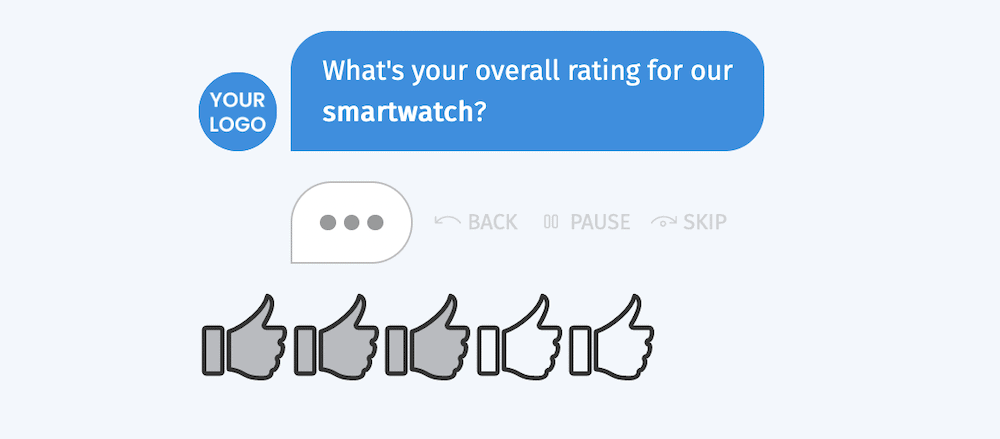
In most cases, the points have a rating relating to how agreeable the respondent is: Often, you’ll see “Strongly Agree” to “Strongly Disagree” with the third point in the row deemed as a neutral opinion.
However, you’ll also find rating scales that use “Very Often” to “Never,” “Very Good” to “Very Poor,” and even “Yes/No” answer choices in some cases depending on the context of the question. Again, you can find ordinal and numeric values in place too for specific statements and question types.
The scale takes its name from creator and psychologist Rensis Likert, and it is a long-standing and time-honored way to collect opinions on and measure attitudes towards existing and new products, services, and more.
For example, a Likert scale survey is a staple of customer satisfaction surveys, service level satisfaction questionnaires, event feedback forms, and other similar surveys.
The Benefits of Likert Scale Surveys (And Why You Should Use Them)
Given how ubiquitous the Likert scale is among public-facing services, it must do a lot of things right! There are plenty of plus points for both the respondent and the researcher. The major benefit is how simple the Likert scale is to adapt to your needs and use.
For the respondent, even a 20-question online survey could take a couple of minutes. This is due to the familiar and consistent format of the questions, and layout of the survey.
In fact, you could get many more answers and insights than a typical feedback form, because a respondent can answer more questions in the same timeframe. What’s more, those taking the survey don’t have to undertake too much thought. Instead, they’ll choose from the pre-selected answer options and move on to the next question. This can up your completion rates, which gives you better quality data to work with.
Speaking of which, researchers can also reduce the time it takes to analyze the number of responses. The combination of consistent answer formats, lack of exposition (through free text fields and other user input,) and compartmentalized opinions in the form of the set answer choices is a boon. A researcher can import the responses somewhere for further analysis, and pore over those responses using charts and graphs.
On the whole, Likert scale surveys are fantastic for collecting subjective opinions and attitudes, and carrying out objective analysis – the ideal data source for improving your business.
How to Create Likert Scale Surveys
A Likert scale survey has a formulaic and consistent layout on the front end, but this belies how complex they are to create and implement on a website. If you have coding knowledge, you could create something suitable for your own needs, but there are various drawbacks:
- First, you’ll need the ability to create all parts of your survey and the customer experience using code.
- You’ll also need to factor in the time it takes to create the survey and iterate through every ‘draft’ and version you create before it goes live.
- There will always be bugs in software, and your survey will be no exception. You’ll have to find them before a user does and get rid of them.
- There’s going to be a lot of upkeep and maintenance for any custom-coded solution, so this will also impact your time and resources.
You’ll have to dedicate a lot to create a custom Likert scale survey using code. If you’re a WordPress user, a plugin would be a suitable alternative. In fact, there are plenty of solutions available, but they won’t all offer the right functionality you need to create a Likert scale survey. There is one we recommend though, and we’ll look at this next.
How Tripetto Can Help You Create Engaging Likert Scale Surveys
Tripetto can offer you almost everything you need to create smart forms, surveys, questionnaires, and more. Although a Likert survey is straightforward in principle, it can escalate in complexity. As such, you’ll want to have some essentials on hand:
For instance, having a visual representation of your survey’s structure is important. Tripetto offers a visual builder that uses drag-and-drop functionality:
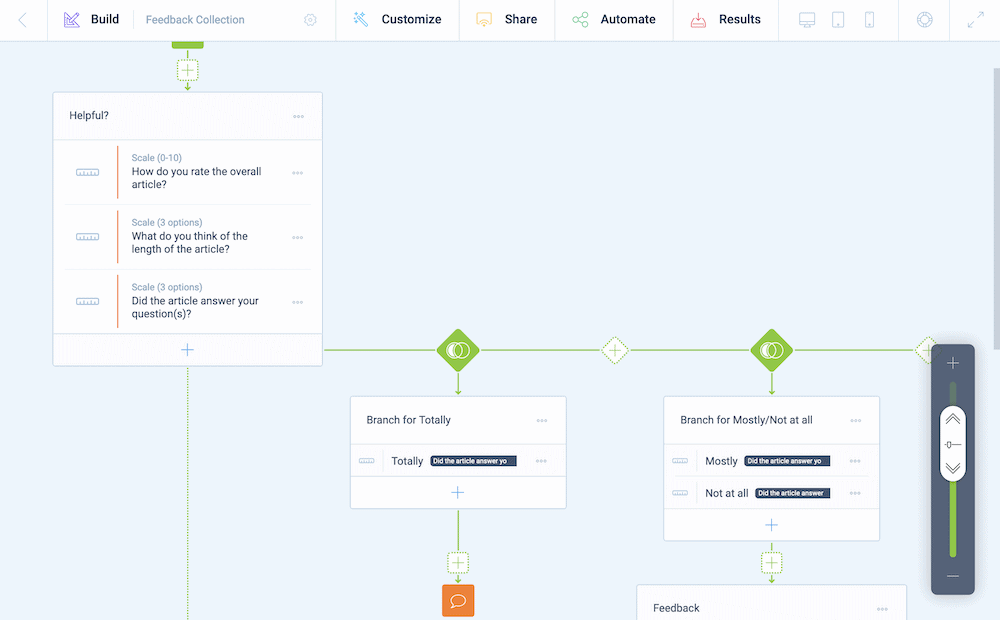
This gives you a ‘flowchart-like’ overview of your survey, which can help you see the paths a respondent can take, at a glance. This might mean you need conditional logic, something that Tripetto provides in lots of ways.
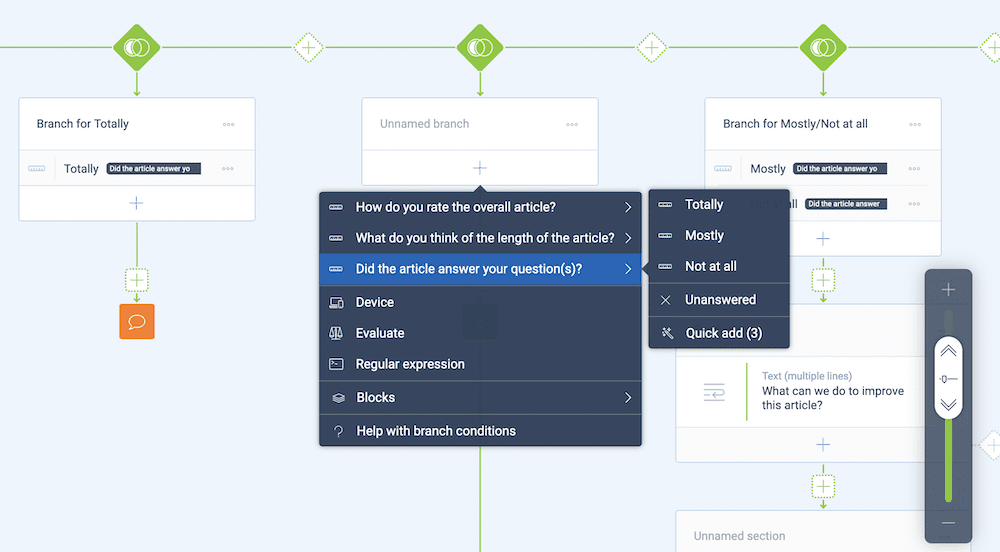
For example, you can choose from a number of logic types. You could branch off from a specific question based on the answer you receive, which will not only let you offer more questions in one survey, but give the respondent more relevant questions. This is another way you can boost your completion rates, and/or reduce drop-offs.
When it comes to analysis, you might have a third-party solution that you work with on a regular basis. Tripetto can do this using webhooks. If you connect with a service such as Zapier, Pabbly Connect, or Make, you can link to thousands of other services in a flash without the need for code.
What’s more, the responses you receive will stay within your WordPress installation. This means you’ll not have to concern yourself with third-party servers, and can keep your data safe and sound.
Creating a Likert Scale Survey Using Tripetto
Once you download, install, and activate Tripetto, you’ll want to head to the visual builder to begin your own Likert scale survey. The Tripetto > Build New Form screen within WordPress includes two options. You can use a form face…
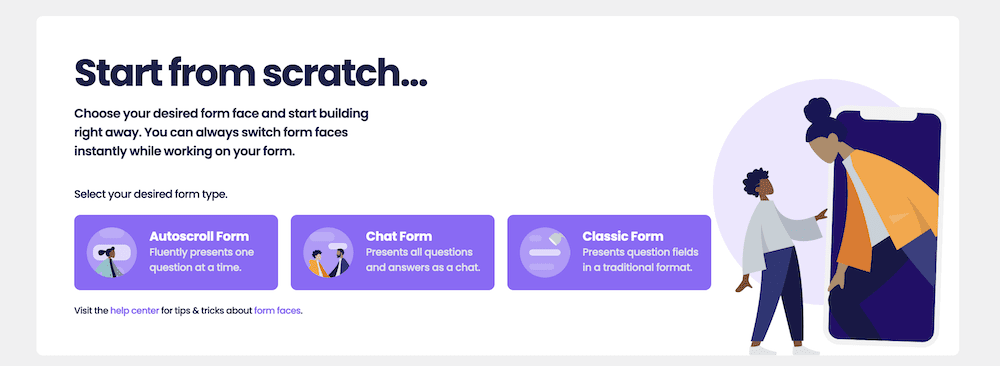
…or a template:
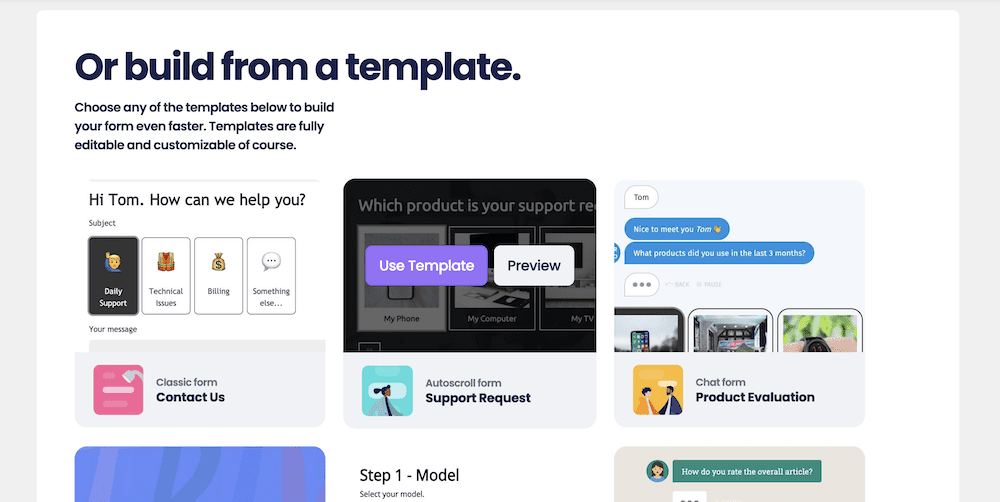
Form faces are like a ‘skin’ for your form, but don’t touch the underlying functionality. This lets you create a workflow fast, without the need to rearrange and redesign your forms. There are three different form faces to choose from:
- Classic form face. This looks like a typical form, with no flow elements. It’s simple and effective.
- Autoscroll form face. If you want to highlight each question, an autoscroll form face is a good idea. If you have experience with Typeform, this form face will feel familiar.
- Chat form face. You can ramp up the conversational tone of your forms using the chat form face. It could help you get a better quality of answers from the respondent.
Your choice here will be based on your desires. None are any worse than the other. Our advice (if you want to start from a form face) is to select one you like. After all, you can change this at any time from within Tripetto’s settings:
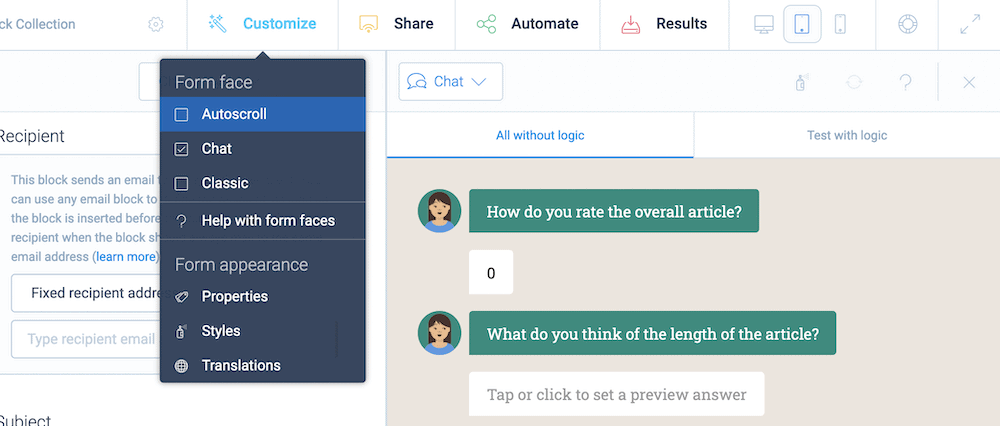
A template could be a better starting point if you don’t know how you’d like to present your form. There are many pre-built templates available, including some for Likert scale surveys:
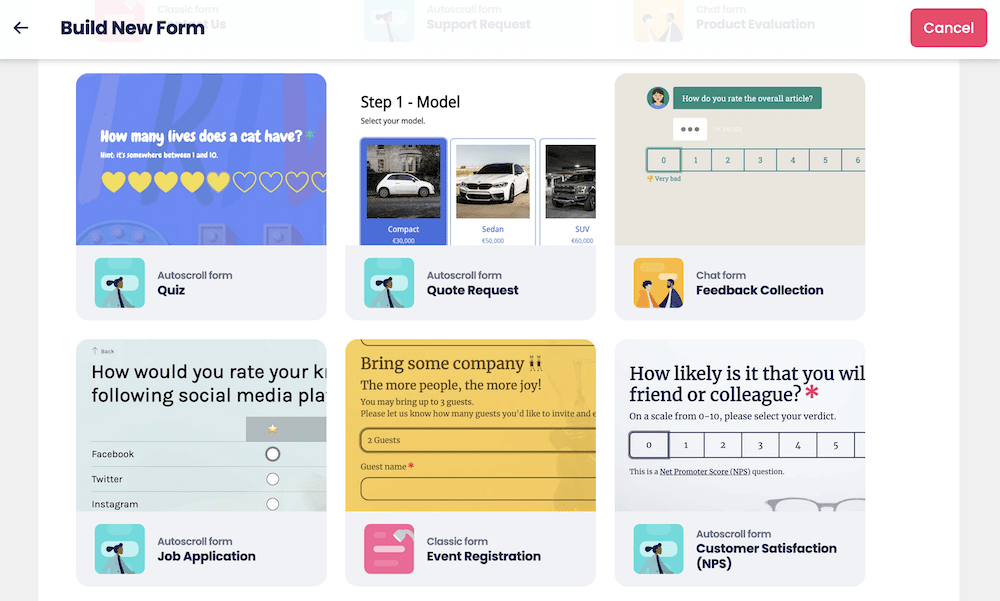
From there, you can begin to build out your questions and implement conditional logic to improve the overall experience. Tripetto includes a number of ideal Blocks to help you build out a Likert scale survey:
- Scale Block. The scale is the foundation for all Likert-type surveys. Tripetto lets you choose from numeric- or text-based scales, and you can attach scores to each rating too.
- Rating Block. You can choose to present your five-point or seven-point scale in different ways. The Rating Block enables you to do this. Within its options, you can select the rating marker ‘shape’ and what your rating scale goes up to.
- Matrix Block. A matrix will let you ask multiple questions using columns and rows. They are fantastic for grabbing opinions on a collection of statements.
- Multiple Choice Block. A typical Likert scale won’t use multiple choice options in the traditional sense, but it’s a handy option to have. It can help you prefilter the respondents and ask them the right questions later.
- Picture Choice Block. You’re also able to use images within the choices, using a dedicated Block. Tripetto’s versatility means you can combine these multiple-choice options to help you segment the user base, before you bring them to your Likert scale survey proper.
However, there are more elements you’ll want to utilize to create your surveys. Next, we’ll look at conditional logic.
Conditional Logic
If you want to create a smart, conversational, and relevant Likert scale survey that can see your completion rate rise, conditional logic will be one method you’ll employ. It’s how you’ll ask engaging questions, skip over irrelevant ones, and much more.
There are lots of ways to implement conditional logic within Tripetto, but one of the most effective (yet simple) is through branch logic. This is where you’ll diverge from the standard line of questioning based on the user’s responses.
Between Tripetto’s storyboard and the full-featured preview, you can test out this branch logic and see how the form works in practice:
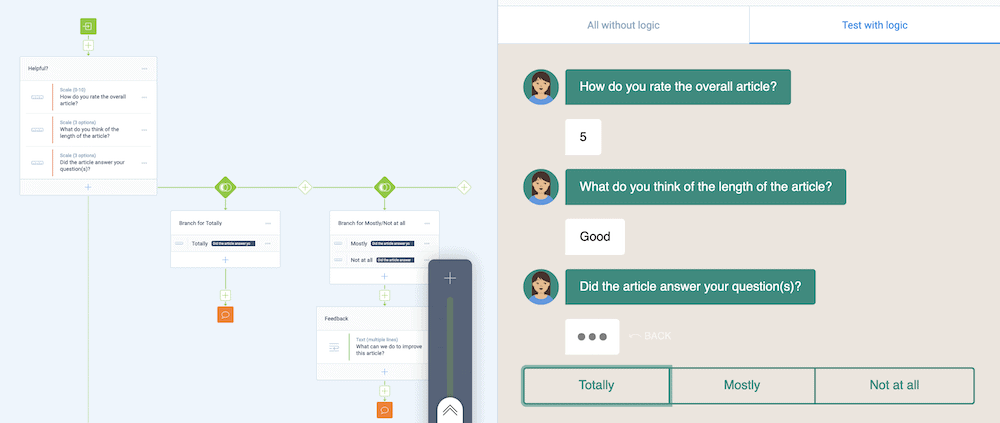
However, this isn’t all. For example, you can recall values and reference them elsewhere within your form using custom variables and automatic calculations. This can be as simple as referencing the answer to a previous question using a combination of different Blocks and options:
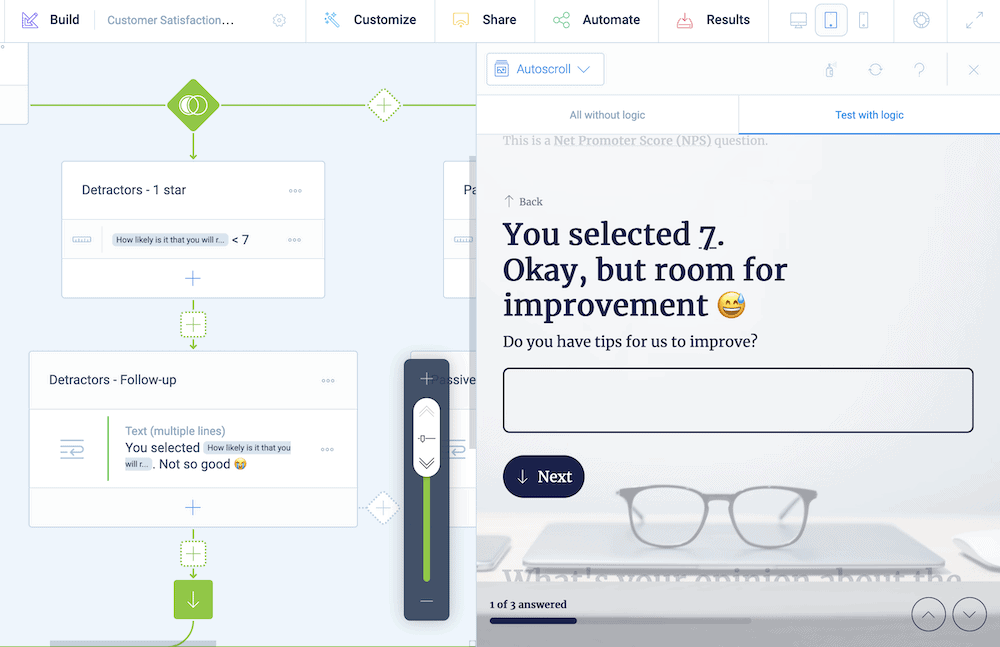
There are many other elements and blocks that can help you implement conditional logic. You’re able to perform advanced calculations, use hidden fields, and more. However, you can also affect the flow of the form using conditional logic too.
For instance, you could ‘pre-qualify’ a respondent using a simple set of questions, and invoke the Force Stop Block if the user doesn’t meet your conditions:
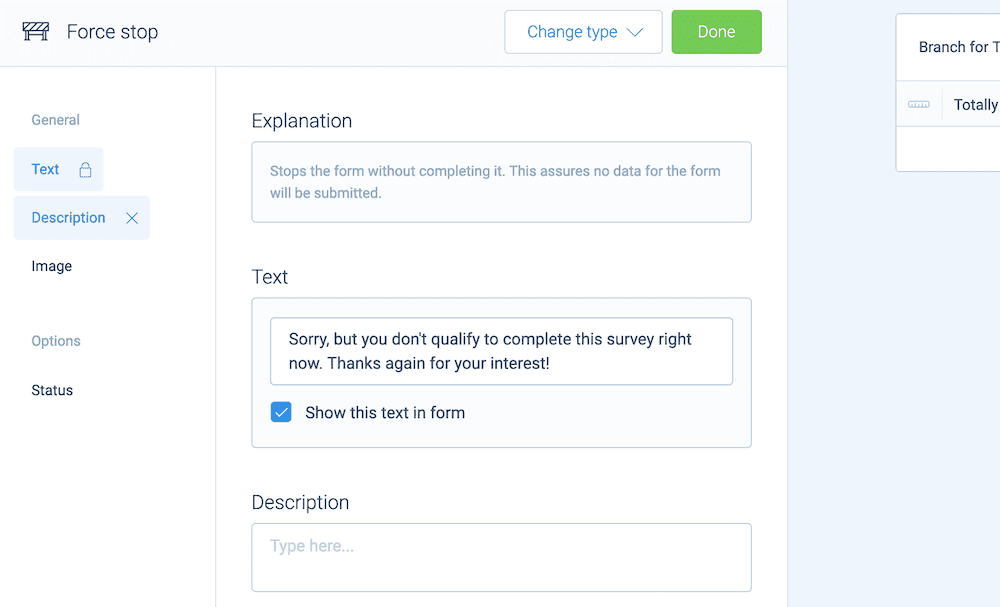
This will be valuable to obtain better-quality answers, but it also helps serve another purpose. You can use the Force Stop Block for age restriction, especially if your Likert scale surveys discuss adult content, alcohol, tobacco, gambling, or other age-specific content.
Integrating Other Services and Sharing Surveys
To paraphrase another saying, no form is an island. This means you’ll either want to share it with others or bring in some of your favorite third-party services to enhance the experience. Sharing is straightforward: There are a number of options within the Share section of the storyboard:
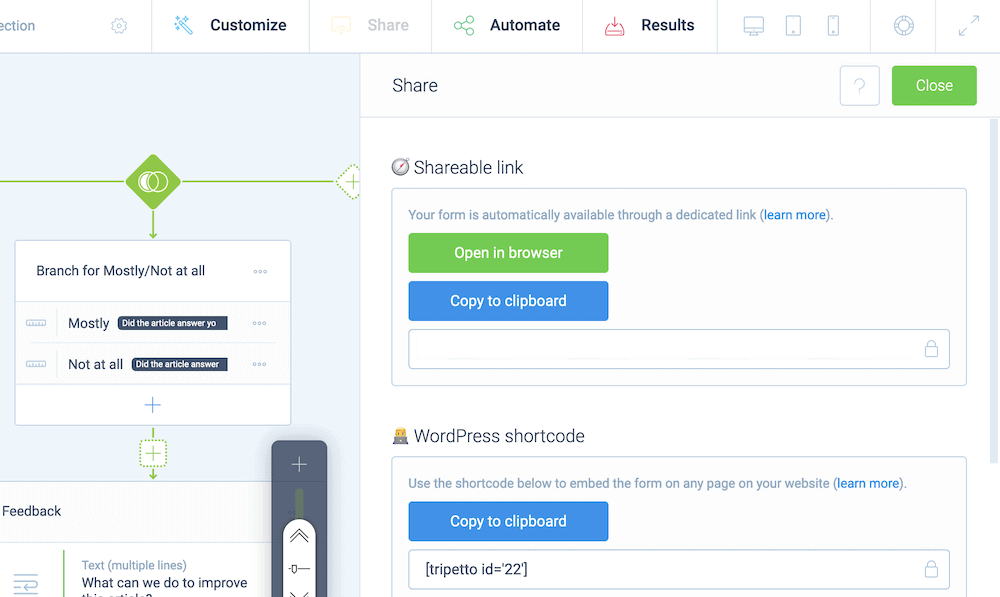
You can use the direct link to share your form through social media. However, you have lots of options to display the form on your site. The WordPress shortcode (along with the dedicated Elementor widget) lets you place the form almost anywhere on your site, and comes with a mountain of options to help you tailor the presentation to your liking:
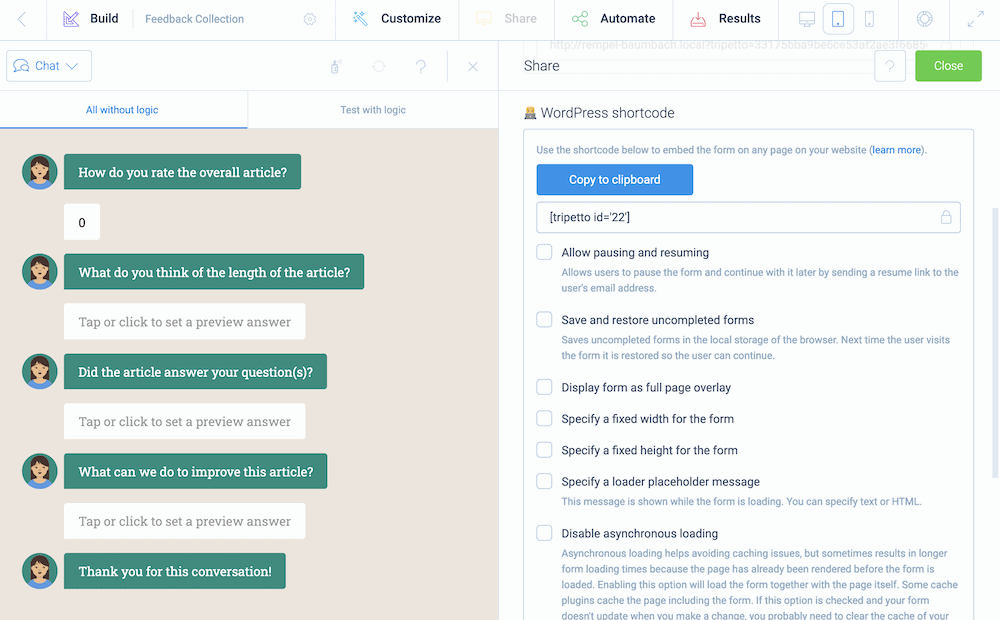
If you have a favorite third-party service that you’d like to bring into Tripetto, you can do so using webhooks. If you combine this functionality with a no-code solution such as Zapier, Pabbly Connect, and Make, you can integrate thousands of different services.
For example, you might want to connect to Mailchimp in order to bring respondent detail to that platform. You could also connect to Google Sheets to further analyze the data you collect.
You might also want to take a hands-off approach to notifications. You’re able to do this if you connect to services such as Slack and/or use a Send Email Block:
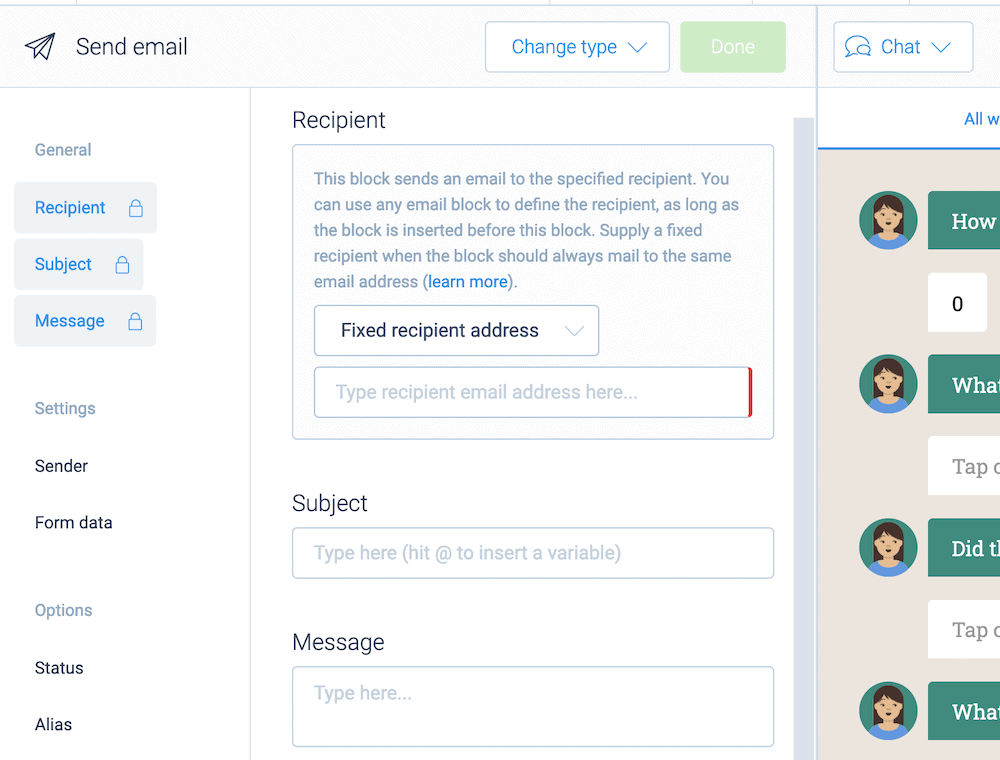
This means you can receive a notification whenever a respondent completes one of your Likert scale surveys. You might even use this for further engagement, such as sending confirmations to the user, thanking them for completing the survey, and other outreach opportunities.
On the whole, you are free to run other aspects of your site and business, without the need to check for completions.
Tripetto Pricing
Unlike other similar plugins, Tripetto gives you the entire feature set and experience regardless of the tier you choose. Your budget doesn’t determine the functionality you have to play with, so all you’ll need to do is decide how many licenses you need:
- A single-site license is $99 per year.
- Five licenses will cost $349 per year.
- $799 per year will give you as many licenses as you need for your sites.
Top Tips to Build Useful Likert Scale Surveys
When you look to build your own Likert scale surveys, you’ll likely want to create the best and most optimal versions possible. There are lots of things you can do to make sure you create an engaging survey, but if you ask relevant questions using Tripetto’s conditional logic, you’ll have a good foundation. Here are a couple of examples:
- For instance, if the user responds positively to a question, you can dive deeper into that response using questions with greater detail.
- In contrast, if you get a negative statement response, your line of questioning should aim to grab more details on why. You always want to get more context to the response. For example, a product feedback survey should ask about how a user interacts with a product, what tasks they use the product with, and more.
There are a few other tips we can note here too, in order to help you build the best Likert scale survey you can:
- Look to use specific wording within your questions. Adjectives such as “kind of,” “quite a bit,” and “sort of” are too vague to be useful.
- Keep your questions relating to one topic, as this will provide more focus for the user, and help you analyze your responses.
- Have a point of analysis in mind for your Likert survey, and know what you want to measure. These types of surveys are fantastic to judge satisfaction, mood, and similar traits.
With these points in mind, you’ll have plenty to work with for your own Likert scale surveys – and hopefully plenty of quality responses too.
Conclusion
A Likert scale survey can help you understand how customers feel about your products and services in a way they will be able to articulate. However, you’ll want to use the right WordPress plugin to create and implement your own surveys.
Tripetto is simple to use, powerful and can help you achieve a sleek, professional result every time. In fact, the user base has its own opinions. For example, user remrick notes that …”Tripetto is amazing at every level…,” while brokrbindr states, “…we have embraced Tripetto as our primary supplier for data-collection forms…”.
Tripetto costs $99 per year for a single site license, and comes with a 14-day money-back guarantee – no questions asked.

